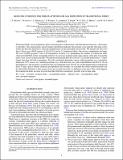Files in this item
Herschel evidence for disk flattening or gas depletion in transitional disks
Item metadata
| dc.contributor.author | Keane, J.T. | |
| dc.contributor.author | Pascucci, I. | |
| dc.contributor.author | Espaillat, C. | |
| dc.contributor.author | Woitke, P. | |
| dc.contributor.author | Andrews, S. | |
| dc.contributor.author | Kamp, I. | |
| dc.contributor.author | Thi, W.-F. | |
| dc.contributor.author | Meeus, G. | |
| dc.contributor.author | Dent, W.R.F. | |
| dc.date.accessioned | 2014-08-29T12:01:03Z | |
| dc.date.available | 2014-08-29T12:01:03Z | |
| dc.date.issued | 2014-06-01 | |
| dc.identifier | 144262198 | |
| dc.identifier | 8f09d982-587c-4037-bcc0-fad186182140 | |
| dc.identifier | 84901020703 | |
| dc.identifier | 000336246700058 | |
| dc.identifier.citation | Keane , J T , Pascucci , I , Espaillat , C , Woitke , P , Andrews , S , Kamp , I , Thi , W-F , Meeus , G & Dent , W R F 2014 , ' Herschel evidence for disk flattening or gas depletion in transitional disks ' , Astrophysical Journal , vol. 787 , no. 2 . https://doi.org/10.1088/0004-637X/787/2/153 | en |
| dc.identifier.issn | 0004-637X | |
| dc.identifier.uri | https://hdl.handle.net/10023/5296 | |
| dc.description | I.P., J.T.K., C.E., and S.A. acknowledge NASA/JPL for funding support. | en |
| dc.description.abstract | Transitional disks are protoplanetary disks characterized by reduced near- and mid-infrared emission, with respect to full disks. This characteristic spectral energy distribution indicates the presence of an optically thin inner cavity within the dust disk believed to mark the disappearance of the primordial massive disk. We present new Herschel Space Observatory PACS spectra of [O I] 63.18 μm for 21 transitional disks. Our survey complements the larger Herschel GASPS program ("Gas in Protoplanetary Systems") by quadrupling the number of transitional disks observed with PACS in this wavelength. [O I] 63.18 μm traces material in the outer regions of the disk, beyond the inner cavity of most transitional disks. We find that transitional disks have [O I] 63.18 μm line luminosities ∼2 times fainter than their full disk counterparts. We self-consistently determine various stellar properties (e.g., bolometric luminosity, FUV excess, etc.) and disk properties (e.g., disk dust mass, etc.) that could influence the [O I] 63.18 μm line luminosity, and we find no correlations that can explain the lower [O I] 63.18 μm line luminosities in transitional disks. Using a grid of thermo-chemical protoplanetary disk models, we conclude that either transitional disks are less flared than full disks or they possess lower gas-to-dust ratios due to a depletion of gas mass. This result suggests that transitional disks are more evolved than their full disk counterparts, possibly even at large radii. | |
| dc.format.extent | 24 | |
| dc.format.extent | 657104 | |
| dc.language.iso | eng | |
| dc.relation.ispartof | Astrophysical Journal | en |
| dc.subject | Accretion | en |
| dc.subject | Accretion disks | en |
| dc.subject | Circumstellar matter | en |
| dc.subject | Infrared: stars | en |
| dc.subject | Protoplanetary disks | en |
| dc.subject | Stars: pre-main sequence | en |
| dc.subject | QB Astronomy | en |
| dc.subject.lcc | QB | en |
| dc.title | Herschel evidence for disk flattening or gas depletion in transitional disks | en |
| dc.type | Journal article | en |
| dc.contributor.institution | University of St Andrews. School of Physics and Astronomy | en |
| dc.identifier.doi | 10.1088/0004-637X/787/2/153 | |
| dc.description.status | Peer reviewed | en |
This item appears in the following Collection(s)
Items in the St Andrews Research Repository are protected by copyright, with all rights reserved, unless otherwise indicated.

